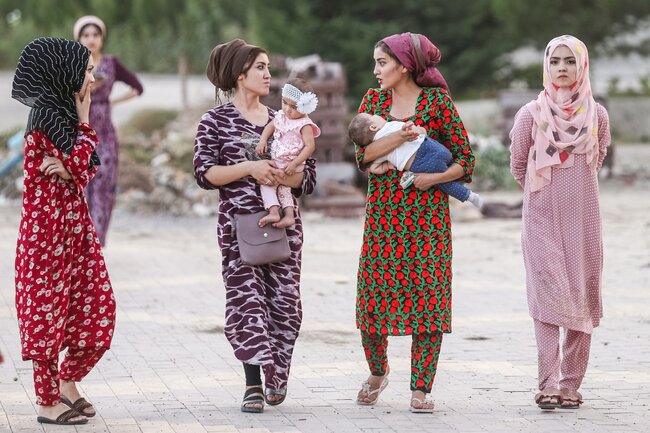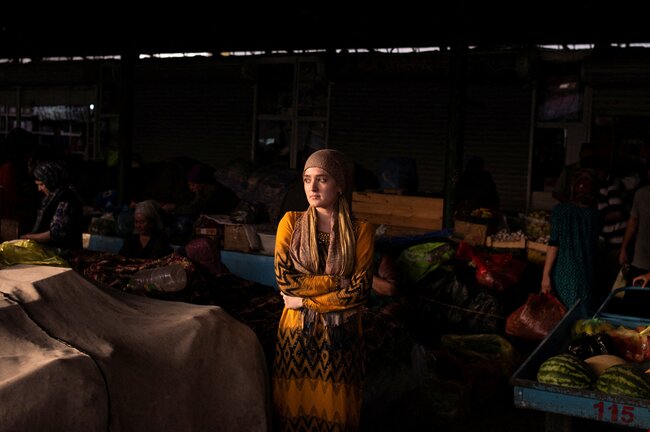This article was produced for ProPublica’s Local Reporting Network in partnership with Capitol News Illinois. Sign up for Dispatches to get stories like this one as soon as they are published.
- Stores Don't Survive: The government puts millions of dollars into opening groceries in food deserts. Many struggle to make it.
- Illinois’ Track Record: In 2018, Illinois officials highlighted the opening of six stores through a $13.5 million grocery initiative. Four of them have closed.
- Search for Interventions: Pricing is a major issue for independent stores. Experts proposed interventions including increased government investment and renewed enforcement of antitrust laws.
These highlights were written by the reporters and editors who worked on this story.
CAIRO, Ill. — More than 100 people congregated in the parking lot of Rise Community Market on its opening day a little over a year ago. As they listened to celebratory speeches, the audience erupted into joyful exclamations: “Mercy!” “Wonderful!” “Wow!” “All right!” Colorful homemade signs raised by local leaders beckoned the crowd to join in: “We!” “Are!” “No!” “Longer!” “A!” “Food!” “Desert!”
For most American cities, the opening of a new grocery store barely warrants a mention. But in Cairo, the government seat of Illinois’ poorest county and the fastest-shrinking one in America, business openings are rare. And for residents who for years had to travel long distances to buy food, it was a magical moment.
“Access to healthy foods and fresh produce is not just about groceries. It’s about justice,” declared Juliana Stratton, Illinois’ lieutenant governor, to the cheering crowd that gathered in Illinois’ southernmost city.
Cairo, she said, had set the stage for what was to come as Illinois embarked on its new grocery store initiative — a $30 million endeavor to build and sustain new food businesses in distressed small towns and urban neighborhoods. Stratton had assisted Cairo leaders in securing state funds from another source because Rise came before the launch of the grocery program, and she told the crowd it would serve as a beacon: “I want you to know, Cairo, Illinois, this is only the beginning, and you are leading the way.”
Within months, however, the store fell on hard times. Rise struggled to compete with national chains on pricing and then faced additional challenges when a walk-in cooler broke a few months later, making it impossible to keep perishables on the shelves between orders. Although sales were initially strong, they slumped as residents fell back into old shopping patterns, patronizing the two nearby Dollar General stores or traveling to Walmart and other supermarkets at least 30 miles outside of town. As fewer customers came in, the store had less money to restock its most popular items. Shelves grew emptier.
Clarissa Dossie, a cashier at Rise since its opening, said that during the worst months, people would come in, look around and say, “Dang, where the groceries at?”
By December, six months after it opened, Rise was in peril.
Over the past decade, state and federal governments have invested millions of dollars in creating grocery stores in food deserts — defined by the U.S. Department of Agriculture as any low-income urban neighborhoods without a grocery store within a mile, and any rural communities without one within 10 miles. These programs continue to expand.
Established in 2011 during Barack Obama’s presidency, the Healthy Food Financing Initiative marked the federal government’s first coordinated effort to tackle the grocery gap. Since then, Congress has allocated an average of $28 million annually across three federal agencies responsible for its administration. Then in 2021, the program received an unprecedented funding surge to $183 million, boosted by federal pandemic recovery funds to the USDA.
In addition to Illinois, numerous states, including Pennsylvania, New York, California, Ohio, Minnesota and Kansas, have implemented programs of their own, as have several municipalities, including New Orleans and Houston.
The concept appears straightforward: Use government funds to help build stores, shorten the trek for fresh food, and in the process, make people healthier and bolster the local economy. In distressed communities, grocery stores have been shown to anchor business development, help grow the tax base and even boost home values, according to one study of Pennsylvania’s program. The converse is also true: “Without the grocery store, communities just have a really hard time succeeding economically,” said Christopher Jones, a senior vice president with the National Grocers Association.
But the way Rise Community Market has struggled in Cairo illustrates how these programs fall short. Because what happens after a store opens is just as important — and despite the up-front financial investments, that hasn’t been solved at all.
When Subsidies Aren’t Enough
Many stores that receive subsidies shutter their doors soon after opening or fail to open at all. Capitol News Illinois and ProPublica examined 24 stores across 18 states, each of them either newly established, preparing to open or less than five years old when they received funding through the federal USDA Healthy Food Financing Initiative in 2020 and 2021. As of June, five of these stores had already ceased operations; another six have yet to open, citing a variety of challenges including difficulties finding a suitable location and limited access to capital.
Illinois’ record is similarly disappointing. In 2018, Illinois officials highlighted the opening of six grocery stores that had received startup funds over several years from a $13.5 million grocery initiative of former Gov. Pat Quinn’s. Four of them have closed.
Despite the expansion of USDA’s program, the federal agency has not studied how long the grocery stores it helps to open actually stay in business or why some of them close. Illinois never did a comprehensive review of its prior program either but as part of its new effort has funded a study of what’s causing food deserts, including the challenges facing independent grocers.
Emerging stores struggle for many reasons. Food deserts are, by definition, areas with depressed economies and often declining populations, but certain problems repeatedly bubble to the top.
“The main concern with them is prices,” said Dossie, explaining why some Cairo residents haven’t done much shopping at Rise. The 32-year-old mother of five was unemployed before she became one of the store’s first employees. She shops there to support Rise and because she doesn’t have a car, but she wishes it could offer discounts like chain grocers. “I know, me personally, I have a big family and I need to be able to get bulk for a cheaper amount.”
Her concerns are backed up by an emerging body of academic research suggesting that the conventional wisdom about how to overcome food deserts — building stores in underserved areas — overlooks the fact that prices matter as much as proximity. For all the benefits the opening of a store can bring to a community, if it can’t compete on pricing, it will struggle to survive.
However, it’s exceedingly difficult for independent stores to compete on pricing because they must pay more than national chains to stock their shelves. Although the price differences for shoppers may be only nominal for most individual items, they can add up on a full cart.
Until 40 years ago, the federal government actively tried to help with this: Competition regulators rigorously monitored mergers and enforced the Robinson-Patman Act, a 1930s-era law intended to prevent suppliers from offering better pricing to big retailers than to independent stores. By the 1980s, however, some economists argued that allowing big retailers to expand and negotiate favorable deals would bring lower prices for all. The Robinson-Patman Act, and an underlying desire to protect small businesses, remained popular with the public, so Congress never moved to repeal it, but regulators increasingly stopped enforcing it. This era gave rise to a rash of consolidations and a huge building boom by the likes of Walmart and Kroger. And as the power of retail chains grew, more small businesses folded.
A 2023 USDA report shows that four grocery chains now capture a third of U.S. food sales, marking a major shift in how people buy their food. Rural areas have even fewer choices. In more than 200 regional markets, most of them across the Midwest and South, Walmart and Sam’s Club claim at least 50% of grocery sales, according to an analysis by the Institute for Local Self-Reliance, which advocates for reversing corporate concentration to strengthen communities. Walmart-owned stores claim 60% of grocery sales in the three-county market that includes Cairo.
Places like Cairo, population 1,600, have paid the price: Its residents have spent more money on gas and rides, or settled for less nutritious options at dollar stores. About 17% of Cairo families don’t have a car, according to USDA’s food atlas. The town saw little economic benefit from the estimated $6.4 million annually Cairo spent in recent years on groceries, most purchased out of state. (Cairo is a short drive from both Missouri and Kentucky.)
Now, the pendulum appears to be swinging back amid the shock of rising grocery prices. In a 2021 speech, President Joe Biden declared, “We’re now 40 years into the experiment of letting giant corporations accumulate more and more power. … I believe the experiment failed.” Biden has appointed anti-monopoly advocates, including Federal Trade Commission Chair Lina Khan, who contend that lax enforcement has proven harmful to small businesses, workers, communities and consumers paying higher prices in places where most competitors have been driven out.
Stacy Mitchell, co-executive director of the Institute for Local Self-Reliance, said government funding for grocery stores is important to overcoming high startup costs, but without broader solutions to keep these stores open, “we’re throwing money away.”
“We have to level the playing field,” Mitchell said. “If we don’t have the enforcement of fair competition, these stores are going to be squeezed out the same way that many independent grocery stores have been squeezed out.”
“Lettuce, Oh My Goodness”
It was the arrival of fresh produce that marked a turning point for Steven Tarver, a longtime resident of Cairo.
“We started getting beautiful things — lettuce, oh my goodness,” said Tarver, a friendly community organizer with diamond-studded ears and a hint of a swagger, who helped lead efforts early on to culminate community support behind the idea of opening a co-op.
“Can you imagine at home on a Tuesday, with your skillet going good and that ground beef getting all brown and then you skim all that and you put your McCormick’s in there. And then you got your cheese already sitting over there and you got some salsa and you look in the vegetable box and there’s no lettuce.
“And you think, ‘Man, I can’t go around the corner. I gotta go to Walmart — 35 miles away.’”
Tarver’s obsession with the lettuce became an inside joke among his neighbors who joined him in developing the store. But for him, it was about way more than tacos. The lettuce symbolized a chance for better health in a county where premature deaths are far more common as in other parts of Illinois. And it served as a salve for the despair that had gripped the town for years.
“Now,” he says, “I am lettuce full. I buy lettuce when I don’t need it. Because this has been a hot commodity in my world.”
More than 3 million Illinoisans — more than a quarter of the state’s population — live in food deserts. People of color are far more likely to live far from a traditional grocery store — the result of complex and sometimes racist practices, including unfair lending and persistent financial neglect from both public and private sectors. That’s why some advocates resist the “food desert” phrase: They say the situation is not a naturally occurring phenomenon but the result of deliberate policies; they call it “food apartheid."
Many of those dynamics were at play in Cairo, positioned at the confluence of the Ohio and Mississippi rivers and, at one time, a thriving transportation hub. It drew people from across the region to its entertainment venues and retail shops, including dozens of food markets— one on nearly every corner.
Yet the town’s fortunes dwindled as river ports were replaced by trains and then interstates elsewhere. The Civil Rights era inflicted particularly severe wounds upon Cairo’s Black community as white business owners, refusing integration, abandoned the town.
Like much of rural America, Cairo continued to shrink. But it managed to hang on to a grocery store until 2015, when its last independent store, Wonder Market, closed its doors in the middle of town, not far from where Rise is today.
Then, in the second half of the decade, the U.S. Department of Housing and Urban Development stepped in and demolished several public housing complexes, displacing hundreds of people. Speaking to a congressional panel in 2017, then-HUD Secretary Ben Carson described the community as “dying.”
The negativity infuriated people like Tarver. It also fueled them. They courted housing developers and prospective business owners to invest in the town. Some made commitments — one even posted a sign announcing plans for a new grocery store. But all the deals eventually fell through or were short-lived.
When hope of a grocery store evaporated, U.S. Sen. Tammy Duckworth’s office reached out to Dollar General on behalf of Cairo officials in 2018 to request the addition of produce at its stores. A corporate spokesperson said that Dollar General informed Duckworth’s office at the time that it did not have plans to add produce to either store but would keep the request in mind for the future. Town officials said they didn’t hear anything more from Dollar General in the years that followed.
Finally, in late 2021, a team of rural development experts from the University of Illinois Extension and Western Illinois University suggested they could build a cooperative grocery store, a local ownership model that some distressed towns are trying out.
By then, it felt urgent. The town needed a lifeline.
After 18 months of planning, in June 2023, the store opened — with balloons, signs and cheers. The team had raised $750,000 in private donations and government grants to support the store, including $186,000 in state funding from a program to help disadvantaged communities, funded by marijuana sales.
For Tarver, it was also validation that their efforts had paid off and could again.
“It means a lot because it was going to be able to show others that’s been talking and downplaying Cairo and saying that ‘we don’t have’ and ‘we can’t do’ that we can if we’re given the opportunity,” Tarver said. “Now, we could talk about housing, we could talk about a hospital, we could talk about other things and meet some voids.”
The Downturn
The frustrations started immediately.
Just before the grand opening of Rise, the two Dollar Generals that had rebuffed requests to add fresh foods to their shelves reopened after renovations, stocked with expanded freezer and refrigerator sections. One of the stores even added an entire row of fresh produce.
A Dollar General spokesperson said in a statement this week that the company made the decision to remodel its two Cairo stores in the fall of 2022 as part of an ongoing, nationwide store improvement program. “We were unaware of any planned grocery co-op when those decisions were made,” the company said.
Robert Edwards, Rise’s manager, said over the last year he’s done his best to keep prices competitive. He even goes into Dollar General and the out-of-state Walmart people most frequent to check what competitors are offering. He works with a wholesaler out of Indiana that purchases in bulk for multiple independent stores, an attempt to leverage the lowest prices they can.
But there are some deals that the store just can’t afford to match. “There are things I can go to Walmart and buy cheaper than I can get from my wholesaler,” Edwards said, though supplier contracts don’t allow him to do that.
He also said some suppliers simply won’t mess with a small store. For months, Edwards watched in frustration from the parking lot as a Frito-Lay truck made deliveries at the Dollar Generals just to the north and south of Rise while it refused to stop at the co-op.
He and others stress to residents that the spending at the co-op benefits the community and that the cost of gas to travel 30 miles makes up much of the difference in prices. But the reality is that people, especially large families, are continuing to leave town for most of their shopping.
The store experienced other problems as well. Eager to fill a void in this one-restaurant town, the co-op board members opened an adjacent cafe that sold hot pizza, fried chicken and sides. But it didn’t bring in customers like they’d hoped and bled thousands of dollars instead, forcing its closure in October. It also drained what savings the store had.
Around the same time, the walk-in cooler that the store had purchased secondhand to save money broke, taking with it about $2,000 worth of meat, produce and dairy products it contained. Without the cooler, the store could keep only about 16 gallons of milk on its shelves — a major issue since milk is a key product that brings people into grocery stores.
The store leadership started a GoFundMe, but it raised only about $1,600, a fraction of the $55,000 sought to help replace the cooler and other equipment as well as to restock the store.
Rise was on the brink of closure as bills went unpaid and food orders were skipped.
During a reporter’s visit in late December, there was very little fresh meat or produce on the shelves: a few pieces of chicken in the meat cabinet, a handful of brown bananas in the produce section, gallons of milk set to expire in the next day or two. And only a few heads of wilting lettuce. People began to lose confidence in the store, driving more customers away.
Workers and community leaders pleaded with people to do what shopping they could there. Theresa Delsoin, an 83-year-old author, teacher and retired Peace Corps volunteer, wanted to set an example: She spent more than $500 at the store between Thanksgiving and Christmas.
“I could go on Amazon and buy a jar of honey from anywhere in the world. But I don’t. Because I want to support our store,” she said as she prepared salmon croquettes and a few side dishes in her home from food purchased at Rise.
Dossie, the clerk, said people told her she should start looking for a new job. She told them she wasn’t giving up and that they shouldn’t either: “I’m not jumping ship because we hit a rough patch.”
The store tried to entice people in with coupons and special deals. It brought Santa in for the kids. But not enough people were filling up carts. Grocery stores bank on the holidays to carry them through the slower months that tend to follow. That clearly wasn’t going to happen at Rise.
A few days before Christmas, Edwards sat in his office at the back of the store and wondered how he’d make payroll for his seven employees. In the end, he delayed his own paycheck so that others could receive theirs on time.
Crucial Stores, Hard Answers
State Rep. Mary Beth Canty, who lives near Chicago and sponsored the bill that became Illinois’ grocery initiative, has seen evidence that the investment might not be effective on its own. Last year, to research solutions to food deserts, Canty visited a small supermarket in the tiny town of Winchester, about 50 miles west of the state capital in Springfield, that had been hailed as a success story.
John Paul Coonrod, the store’s board president and chair, said he told Canty during her visit that the state’s initiative amounted to a “drop in the bucket” for what small grocers need to survive.
Great Scott! Community Market did well at first, but it later lost customers to a Walmart and then a new Dollar General that included a grocery market. It was hard to compete, and the store closed just a few months after Canty’s visit — five years after it opened.
John Shadowens, an economic development educator at the University of Illinois Extension, is part of the state-funded group surveying grocery stores across Illinois to identify their main obstacles to staying in business. At seven forums in recent months, Shadowens heard store owners voice consistent concerns about increasing costs of supplies, utilities and labor due to Illinois’ rising minimum wage. However, their primary obstacle, he noted, is their inability to procure food at prices that are competitive enough to attract the customers they need to stay in business.
There aren’t any easy answers. The renewed push for more aggressive antitrust action on grocery pricing remains a contentious proposal. And even if it’s successful, it’s not a fast-acting solution.
A USDA Rural Development spokesperson said the Healthy Food Financing Initiative is helping; in addition to new stores, it has funded farmers markets, delivery services and community groups. For instance, the program recently awarded $1 million to a partnership in southern Illinois working to improve grocery stores’ access to low-cost loans.
Illinois’ new program has partnered with university experts to assist startups and focuses solely on small, independent stores, unlike the previous one, which also supported the development of discount chain Save A Lot stores, an Illinois Department of Commerce and Economic Opportunity spokesperson said.
And for the first time, government-owned stores in Illinois are eligible to apply for state aid. Chicago is the first major city in the nation to consider this option, though underwriting losses with taxpayer funds is controversial.
Reflecting on discussions with grocery store operators during the research team’s travels to various locations across Illinois, Shadowens said he remains hopeful, though he finds it increasingly hard to do so: “We have hours behind the windshield to talk about this: Are we truly helping, or are we providing an autopsy on a patient that’s just not dead yet?”
For now, Cairo’s store is hanging on. In June, the festive balloon arch that punctuated the store’s opening reappeared to mark its one-year anniversary. Edwards, the store manager, said at the member meeting that followed that Rise had received the second half of a philanthropic grant earlier this year, allowing the store to pay off debt, resume regular food shipments and replenish its shelves.
There have been other changes as well. For instance, to replace the shuttered cafe, which required a cook and clerk, the store opened a made-to-order deli at the beginning of the year, which has been more popular among the lunchtime crowd and requires only one employee. In March, after months of waiting, the store was approved to accept government food benefits given to low-income pregnant women and families with young children, commonly known as WIC, which has boosted sales by more than $1,500 monthly.
But sales remain well below where they need to be for the store’s long-term sustainability. It takes about $70,000 a month in sales to break even; Rise has averaged less than half of that in the first six months of this year. When you add up the money spent by Cairo citizens everywhere they shop, they’re spending an estimated $530,000 monthly on groceries, based on sales data for recent years. (This estimate is derived from overall sales data in a three-county region, adjusted for Cairo.) That means that they are spending only about 5% at Rise, when they’d need to spend at least 13%.
Edwards said he’s hopeful the store can reach that point within another year because he understands its importance goes beyond the critical food it provides. It’s also a job and economy creator, a hub of community life and a beacon of hope. It’s crucial to the identity of a place teetering on the brink. In the first few months it was open, Rise hosted a wedding reception, food tasting event, health care expo, a pumpkin carving contest and, for several Wednesdays, a mobile food pantry organized by a local nonprofit. He gave away just-expired food to people stretched out in a line in the store’s parking lot.
“Kroger would never let a food pantry set out in their parking lot giving out free food because it’s going to hurt their sales. It did hurt sales on those days,” Edwards said. “But we’re here to serve the community.”
Alex Abbeduto, formerly of Capitol News Illinois, contributed reporting. Photo editing by Peter DiCampo.
A portion of the reporting in Alexander County is supported by funding from the Pulitzer Center.




